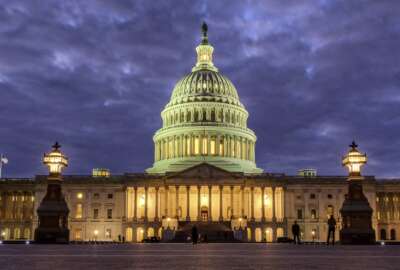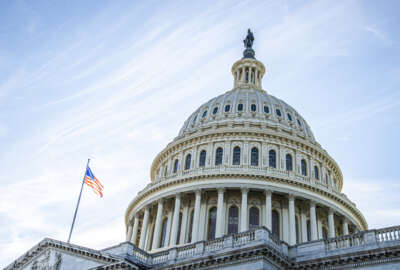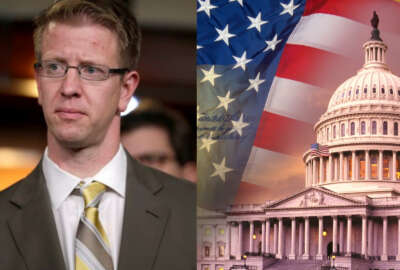DoD to bring back most employees from shutdown furlough
The Defense Department says it's decided it has the legal authority to bring most of its civilian workforce back from furlough even as a government shutdown...
Most of the Defense Department workforce that was sent home at the beginning of the government shutdown will be back on the job this week, the Pentagon said Saturday.
The decision came after DoD and Justice Department lawyers spent five days working to develop a legal interpretation of a last-minute law Congress passed just before the shutdown began. The Pay Our Military Act ensured that uniformed service members would be paid during a shutdown, but also provided for pay to civilians and contractors who “are providing support to members of the armed forces.”
The administration’s interpretation of the law will allow “most” of DoD’s 350,000 currently-furloughed civilians to return to work. Officials were not able to give a precise count of how many would be left sidelined, but Robert Hale, the Pentagon’s comptroller, told reporters Saturday evening that he believed more than 90 percent of the overall civilian workforce would be back on duty and earning pay again this week.
“My guess is that no more than a few tens of thousands will remain on furlough, and it may be substantially less than that,” Hale said. “But I just can’t know until we give the services kind of a day or so to work through the guidance. I hope we can get a substantial number back Monday, but we want to get them all back as soon as we can.”
In a memo implementing the decision to recall furloughed workers, Defense Secretary Chuck Hagel wrote that the Justice Department determined that the law would not allow an across-the-board cancellation of furloughs.
Instead, those returning to work next week will include those who’ve already been excepted from furlough, plus employees in two more categories: employees “whose responsibilities provide support to service members performing active service and their families on an ongoing basis,” and those who “contribute to sustaining capabilities and force readiness.”
The law includes identical pay provisions for employees of the Coast Guard, but that agency’s public affairs office did not respond to queries about whether it intended to recall its furloughed workforce. And the legislation has no effect for furloughed workers from non-defense federal agencies, who collectively have had to send home another 400,000 workers because of the shutdown.
Hagel said the Pentagon would not be providing an exhaustive list of job functions that are being lifted from furlough, and that it would be up to the secretaries of the military services and the heads of other Defense components to make those determinations.
“The guidance does not identify every activity performed by DoD’s large civilian workforce, but rather it provides overarching direction and general principles for making these determinations. It should be applied prudently, and in a manner that promotes consistency across the department.”
Hagel told military leaders to begin making those determinations and notifying employees who are being recalled immediately.
He did, however, provide some specific examples of employees who could be brought back from furlough and who could not. The staffs of the military commissaries that have been shut down since Wednesday could be returned to work, as could employees involved in health care, military family support programs, acquisition management, supply chain management and several other categories.
On the other hand, employees who work in the offices of the department’s chief information officers and deputy chief management officers would not be brought back to work under the changes, nor would legislative affairs and public affairs personnel, employees of the Army Corps of Engineers and auditor staff who are not already exempted.
“Those who are not being recalled provide critical functions,” Hale said. “What they do is important, but because of the letter of the law, we had to identify those people who have less direct effect on military members.”
Rep. Buck McKeon (R-Calif.), the chairman of the House Armed Services Committee, disagreed. In his view, the legislation provided DoD with wide latitude to pay civilians during a government shutdown, and he urged the department to use it in a letter to the defense secretary the day the furloughs began. Nonetheless, he said the Pentagon decision was a positive development.
“I am very pleased to see so many of our national security workforce will be able to return to work,” he said in a statement Saturday evening. “Congress gave the executive branch broad authority to keep our Armed Forces and dedicated defense civilians working throughout the government shutdown. Though I do not believe the law required these hundreds of thousands of workers to be furloughed in the first place, it is welcome news.”
DoD officials said civilians coming back to work from furlough will be paid on time. The next paycheck to the non-uniformed workforce is due Oct. 11, and Hale said non-furloughed employees will definitely be paid for the hours they’ve worked by then.
And it appeared likely Saturday evening that even Defense employees who remained furloughed would get paychecks for workdays during the shutdown period, eventually. The House passed a measure on Saturday that would provide all furloughed federal employees with backpay, and President Barack Obama has said he will sign the measure. But the government would have no authority to issue those particular checks until it has appropriations authority for 2014.
Depending on how long the furlough lasts, DoD’s ability to pay its non-furloughed workforce could change. The Defense Finance and Accounting Service, the agency that provides payroll services to DoD and a handful of civilian agencies, has been unaffected by the government shutdown so far because it operates through a working capital fund that still has a positive cash balance even with no new money coming in. Hale said he estimated DoD only had two more weeks before that fund runs dry.
And Pentagon officials warned that while they now have authority to pay most of their people, the federal government has no authority to spend money for almost anything else.
“The [Pay our Military Act] provides appropriations for personnel; it does not provide appropriations for equipment, supplies, materiel, and all the other things that the department needs to keep operating efficiently,” Hagel wrote. “While the act permits the department to bring many of its civilian employees back to work, and to pay them, if the lapse of appropriations continues, many of these workers will cease to be able to do their jobs. Critical parts or supplies will run out, and there will be limited authority for the department to purchase more. If there comes a time that workers are unable to do their work, I will be forced once again to send them home.”
Even the mechanics of bringing employees back to work could prove a challenging process. In many cases, Hale said, supervisors have no direct communication with their employees, since under a government shutdown they are legally prohibited from checking their work emails or using their government-issued smartphones.
“I think what we will do is issue statements that say you should report back to work on Monday unless you’re in one of the categories where we can’t recall you,” he said. “For those who are, they’ll need to talk to their supervisor about whether there are going to be some selective recalls. It’s going to take a few days. We’re not going to be fully back to work on Monday, but we’ll do it just as quickly as we can. We want them back.”
RELATED STORIES:
DoD would furlough roughly half of civilian workforce during shutdown
DoD works out how military pay bill will impact civilians
House approves backpay for furloughed feds
Copyright © 2024 Federal News Network. All rights reserved. This website is not intended for users located within the European Economic Area.
Jared Serbu is deputy editor of Federal News Network and reports on the Defense Department’s contracting, legislative, workforce and IT issues.
Follow @jserbuWFED






